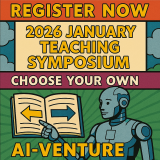
Tips for the Week of May 1, 2023
April 27, 2023
Flipping for Active, Engaged Learning
The term “flipped learning” is no longer new in higher education, but what does it mean for Chapman’s mission of personalized education? Flipped learning is based on an inverted model of traditional teaching, in which students listen to lectures in class and complete learning tasks like problem sets at home. In a flipped model, students engage with course content at home, and engage in tasks such as problem-solving, group discussion, or case analysis in class under the guidance of the instructor. Benefits of this model include:
- allowing students to learn at their own pace,
- encouraging students to engage more actively with lesson material,
- freeing up of class time for more active, creative learning activities,
- providing instructors with more time to interact with students and assess their learning, and
- encouraging students to take more responsibility for, and control of, their learning (Nouri, 2016).
Interested in designing a flipped lesson for your classroom? Contact the CETL team to schedule a consultation.

“Words are a powerful aphrodisiac. They have the ability to awaken emotion, excite the mind and senses…” (Shan O’Conner)
As the poet O’Conner points out, the right choice of words can ignite excitement, curiosity, and passion. But words can also discourage and destroy. Neuroscientists warn that negative words “not only cause situational stress, but also contribute to long-term anxiety” (The Neuroscience Behind Our Words, 2019). Good communication skills are essential to effective teaching. In support of student success, faculty must choose words thoughtfully. Consider the psychological and physiological impact of the language used in your syllabus. What about feedback to students or in assignment expectations? And what about emails sent just before leaving at the end of the day? Language Matters. Do your word choices encourage or discourage, generate curiosity or fear, empower or disempower, include or exclude? Taking time to reflect is important for both faculty and students. For students on the last day, consider these Reflective Activities for the Last Day.
Helping Students Strengthen Their Study Habits
In 2021 study, researchers investigated the important question, to what extent do study habits relate to performance? Not surprisingly, their data showed that students who used active studying strategies, and who were less distracted while studying, performed better on assessments. Based on their results, the authors provided a few suggestions for course structural changes that can help students do well on future assessments.
- Provide students with a low-stakes assignment in which they are asked to submit a short video explaining the strategy they used to solve a problem that was presented in class. A free educational resource students can use to record short videos is FlipGrid.
- When teaching, utilize active study strategies when solving complex problems to demonstrate to students how to use this same approach at home. Throughout each class session, give students additional opportunities to practice these study strategies. For example, have them work with a partner and explain their answer to a poll question.
- To help students stay focused while studying outside of class, organize voluntary student-led study sessions in which you provide a set of additional practice problems. It would also be useful to provide an example of how to properly solve an additional practice question.
Hopefully, your students will benefit from these small changes as they prepare for upcoming assessments, such as finals.
Interested in exploring any of these ideas further or discussing how you might implement them in your own teaching practices? Is there a tip you’ve tried that you would like to share with colleagues? Contact CETL or schedule a consultation to continue the conversation.
